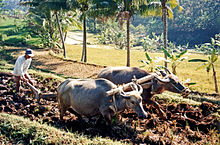 Livestock production systems
Livestock production systems
Animals, including horses, mules, oxen, water buffalo, camels, llamas, alpacas, donkeys, and dogs, are often used to help cultivate fields, harvest crops, wrangle other animals, and transport farm products to buyers. Animal husbandry not only refers to the breeding and raising of animals for meat or to harvest animal products (like milk, eggs, or wool) on a continual basis, but also to the breeding and care of species for work and companionship. Livestock production systems can be defined based on feed source, as grassland – based, mixed, and landless.
Grassland based livestock production relies upon plant material such as shrubland,rangeland, and pastures for feeding ruminant animals. Outside nutrient inputs may be used, however manure is returned directly to the grassland as a major nutrient source. This system is particularly important in areas where crop production is not feasible because of climate or soil, representing 30–40 million pastoralists.[85] Mixed production systems use grassland, fodder crops and grain feed crops as feed for ruminant and monogastic (one stomach; mainly chickens and pigs) livestock. Manure is typically recycled in mixed systems as a fertilizer for crops. Approximately 68% of all agricultural land is permanent pastures used in the production of livestock.[90]
Landless systems rely upon feed from outside the farm, representing the de-linking of crop and livestock production found more prevalently in OECD member countries. In the U.S., 70% of the grain grown is fed to animals on feedlots.[85] Some of the practices used in commercial livestock production, including the usage of growth hormones, are controversial.[91] Synthetic fertilizers are more heavily relied upon for crop production and manure utilization becomes a challenge as well as a source for pollution.
Production practices[edit]
Tillage is the practice of plowing soil to prepare for planting or for nutrient incorporation or for pest control. Tillage varies in intensity from conventional tono-till. It may improve productivity by warming the soil, incorporating fertilizer and controlling weeds, but also renders soil more prone to erosion, triggers the decomposition of organic matter releasing CO2, and reduces the abundance and diversity of soil organisms.[92][93]
Pest control includes the management of weeds, insects/mites, and diseases. Chemical (pesticides), biological (biocontrol), mechanical (tillage), and cultural practices are used. Cultural practices include crop rotation, culling, cover crops, intercropping, composting, avoidance, and resistance. Integrated pest management attempts to use all of these methods to keep pest populations below the number which would cause economic loss, and recommends pesticides as a last resort.[94]
Nutrient management includes both the source of nutrient inputs for crop and livestock production, and the method of utilization ofmanure produced by livestock. Nutrient inputs can be chemical inorganic fertilizers, manure, green manure, compost and minedminerals.[95] Crop nutrient use may also be managed using cultural techniques such as crop rotation or a fallow period.[96][97] Manure is used either by holding livestock where the feed crop is growing, such as in managed intensive rotational grazing, or by spreading either dry or liquid formulations of manure on cropland or pastures.
Water management is where rainfall is insufficient or variable, which occurs to some degree in most regions of the world.[85] Some farmers use irrigation to supplement rainfall. In other areas such as the Great Plains in the U.S. and Canada, farmers use a fallow year to conserve soil moisture to use for growing a crop in the following year.[98] Agriculture represents 70% of freshwater use worldwide

